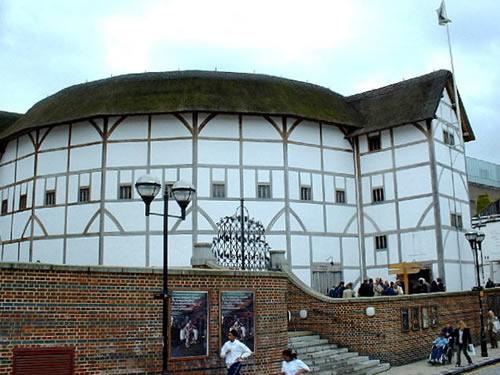
Theatre in the Age of Shakespeare
The theatre in Shakespeare’s time was much different than it is today. Authors wrote plays for the masses, especially those who couldn’t read or write.
The theatre changed a lot during Shakespeare’s lifetime. The authorities didn’t like it and didn’t allow acting in the city itself. They thought it had a bad influence on people and kept them from going to church. Queen Elizabeth, on the other hand, loved acting and helped the theatre become popular.
As time went on more and more popular theatres emerged outside city walls. This was considered an unsafe area with crime and prostitution.
Shakespeare’s theatre was full of life. People did not sit all the time and it was not quiet during the performance. The audience could walk around, eat and drink during the play. They cheered, booed and sometimes even threw objects at the actors.

Elizabethan theatre
Theatres were open arenas or playhouses that had room for up to three thousand people. They were structures made mainly of wood. There was no heating and actors got wet when it rained. The stage was higher and there was an open pit in front of it where most of the people could stand in. Richer people and noblemen sat in the gallery. There was almost no scenery because the dialogue was the most important part of the play. Colourful and well-designed costumes were very important and told the people about the status of a character. Women never performed in plays, so young boys played female characters. The performances took place in the afternoon because it was too dark at night.
There was no stage crew as there is today. Actors had to do everything themselves - from making costumes to setting the stage.
Plays were organized by acting companies. They performed about 6 different plays each week because they needed money to survive. They had almost no time for rehearsals.
The companies in Shakespeare’s time had a hierarchical system.
The company belonged to shareholders and mangers. They were responsible for everything and got most of the money when the company was successful. Sometimes they even owned there own buildings.
Actors worked for the managers and after some time became a permanent member of the company.
Apprentices were young boys were allowed to act in menial roles. They also played females characters in plays.
Lord Chamberlain’s Men and the Admiral’s Men were the two most important companies in London at that time. Among the most famous theatres during were the Globe, the Swan and the Fortune.

The Reconstructed Globe Theatre in London Theatre
A theatre is a place where people go and see all kinds of performances. Most people think of a theatre as a place to see a play, where a story that is acted out in front of an audience. But there are other kinds of performances that take place in a theatre too: musicals, ballets and operas.
The theatre building
Most theatres have three parts: the stage, the auditorium and the backstage area.
The stage is the most important part of a theater. It is the place where actors and actresses perform a play. Most plays are performed on a proscenium or picture-frame stage. The audience can watch the play only from the front. The action takes place under a large arch. A curtain opens and closes at the beginning and end of each scene.
Sometimes the audience can sit on three sides of a stage. Some theatres have a round stage in the middle of the auditorium with spectators sitting around it. Actors get on and leave the stage through the audience.
The auditorium is where the audience sits. Modern theatres also have lobbies, rest rooms, cafes and bars to offer people more comfort before and after the performance, as well as between scenes.
The backstage area is the place where the scenes are prepared and actors and actresses get dressed. There are also storage and office rooms for the staff and theatre workers. There are rooms in which technicians control lighting and sound.
People in a theatre
Many people work together in a theatre. Every production begins with a producer – sometimes a man or a woman, sometimes a whole group of people or a company. Producers have a lot of things to do. They have to collect money for the play, get a story and a usable script. They must be able to work with a good team.
The director decides how the play should be performed. He interprets the script, works together with the people who make the scenery and costumes. The director oversees rehearsals and tells actors how to play their part. In modern plays a playwright writes the script.
Designers create the scenery that shows the time and place of the story. Lighting experts have the job of moving actors or pieces of the stage into the spotlight. Lighting effects help to create the atmosphere of a play.
A casting director takes over the job of selecting actors and actresses for the play. They must choose a person with a suitable voice and character for every role. Make-up artists and costume designers help make the actors look good. Choreographers plan dance steps and other movements.
Actors and actresses are the main people in the play. They must study a character’s appearance, speech, body movements and gestures. Practicing this is not always easy. In order to play a role well the actor must know a lot about emotions and the feelings that someone can have. They must concentrate on their role and keep out everything that may distract them.
Scene design
Designers build the scenery on a stage. Sometimes they don’t have to change it during the play. At other times sets have to be changed quickly during performances. Modern theaters have stages that can revolve or stages that can be raised or lowered.
